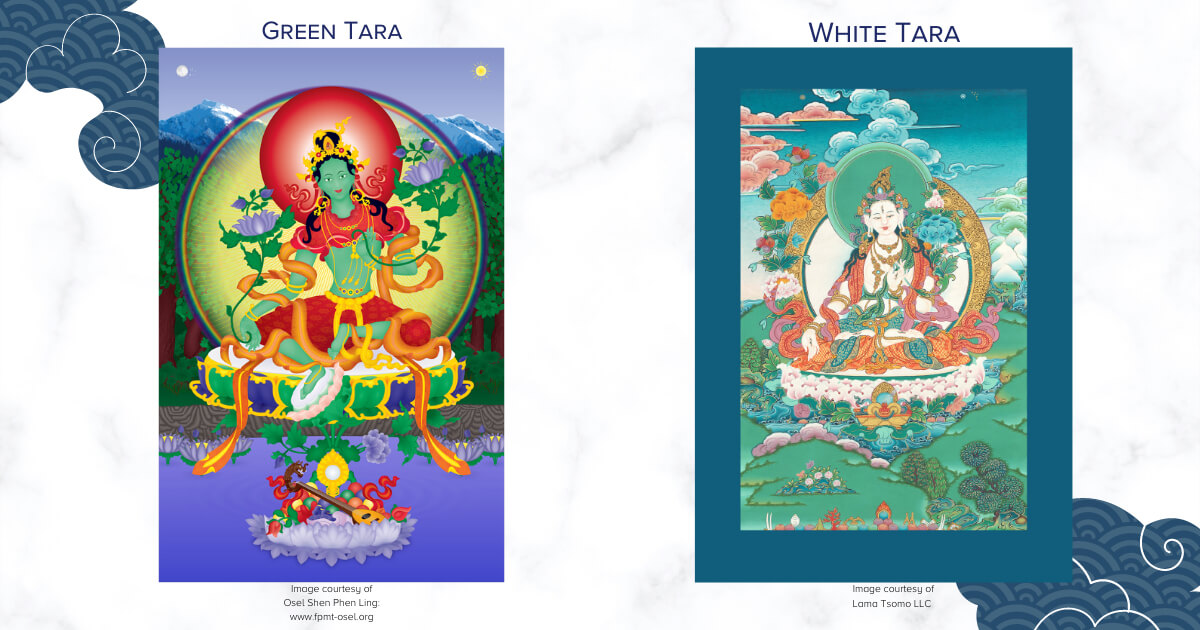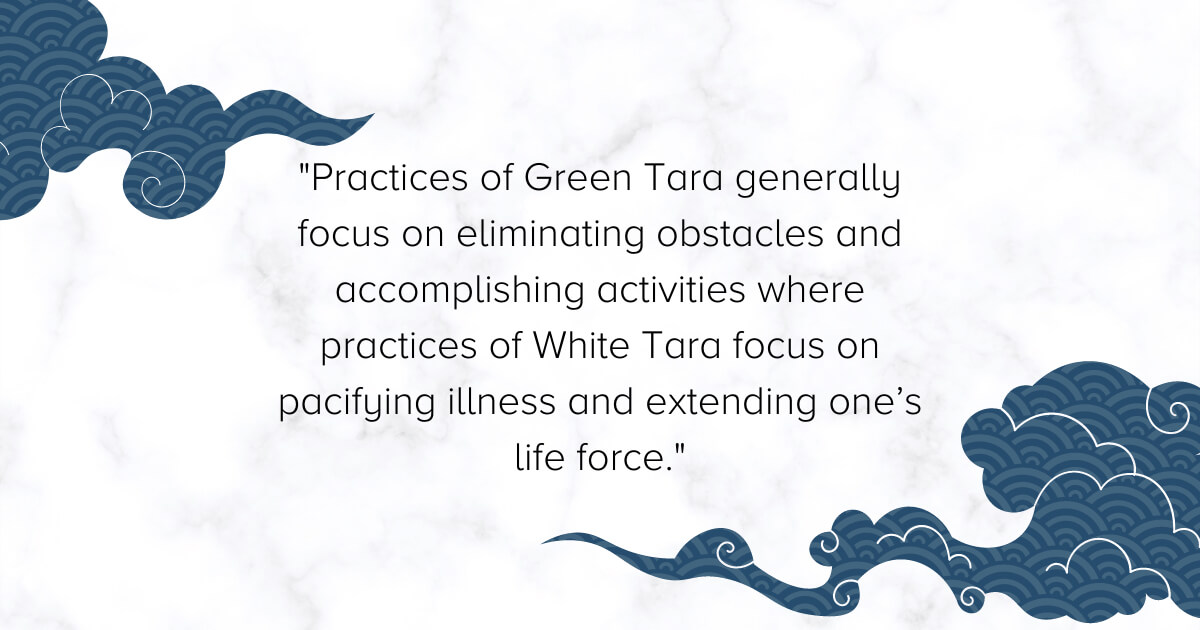Who is Tara?
Tara is most famously known as a female buddha and the embodiment of the divine feminine. She is sometimes referred to as the Tara Goddess. In the Buddhist tradition Tara is also discussed as a female bodhisattva who practiced the Buddhist path and eventually became a fully-enlightened buddha, and at others, as a meditational deity. There is also some overlap in these two. But, before we get to into that, let’s talk about Tara the buddha.
In The Explanation of Tara by Taranatha Kunga Nyingpo, he recounts that long ago there was a princess named Wisdom Moon who had great faith and respect for the Buddha. She had heard the monks say that she should pray to be reborn in a male body so that she could better practice the dharma and serve sentient beings. This was at a time in history when women had even less freedom than today and were entirely subject to the authority of their families and husbands. She replied to them saying, “Here there is no man nor woman—no self, no person, no consciousness. The labels ‘male’ and ‘female’ have no essence; the foolish worldly ones are thoroughly mistaken.”
She was referring to the fact that gender is merely a conventional concept that doesn’t exist in ultimate reality, and so to cling to such ideas was foolish. She thought that there were many men who strove for enlightenment but very few women who had been able to accomplish the benefit of beings. She pledged that she would strive for the benefit of beings in a woman’s body until samsara is emptied. Through all her lifetimes on the paths of training and onwards as a fully enlightened buddha, she has always manifested in a female body.
She remained in the royal palace and through the power of her meditative concentration, she was able to use and enjoy the objects of her senses without attachment and therefore did not need to reject them as would someone on the monastic path. She then attained the state of meditative attainment called “liberating all beings,” by the power of which she was able to liberate many beings from samsara every morning and would not eat until she had established them in the realization of emptiness. She thus attained the name “Drölma” which means, “the Liberator.” She also made an oath before the Buddha Amoghasiddhi to protect beings from harmful obstacles and is praised above all other deities for the clearing of obstacles.
So that is the myth of Tara the woman, the buddha. But what does it mean to practice Tara? What is happening in such a practice?

Tara Meaning: Understanding Ultimate and Conventional Meanings
In Buddhism, when we discuss the idea of a deity, there are two kinds of deity discussed: the conventional symbolic deity, and the true deity of ultimate reality. When most of us think of a deity, we think of someone who looks somewhat human, having eyes and a mouth, and carries around some strange looking ritualistic objects, but that’s not the whole story. A deity’s form conveys a particular feeling when we look at it.
The ultimate reality deity is described in the following lines from The Sublime Continuum by Aryasanga, “Here there is nothing to clear away and nothing to add. When you purely see the utterly pure reality with the utterly pure view, you are completely liberated.” So, the real deity is emptiness, the freedom from all conceptual elaborations, primordial purity.
For example, at the Ewam Garden of One Thousand Buddhas, the central buddha statue is of a deity named Yum Chenmo, the Great Mother. The real Great Mother is the perfection of wisdom itself, emptiness, and not some woman with eyes, a mouth, hands, and feet. In reality, that form is pointing to a true essence: the union of emptiness and compassion. The understanding is that the more profound your realization of emptiness becomes, the more strongly compassion will naturally arise within you. Why? Because that root of all feels ultimate connection and ultimate compassion for all. Its qualities include both emptiness (no form, no solidity) and compassion.
As mentioned earlier, there is also the conventional symbolic deity that has outer characteristics of looking like a beautiful woman. Compared to the true deity of ultimate reality, it is much easier to describe the ultimate reality by relating it to the conventional symbolic deity. This can give us a sense of a Tara definition. We can point to the outer form and characteristics and talk about them, can’t we? It provides us with a convenient basis for discussion. Most likely, no one is going to randomly start a discussion of emptiness and compassion. However, if they see an image of the Great Mother as a beautiful woman and ask who she is or what she represents, profound discussions can proceed naturally.
Similarly, when we are doing a meditation practice based in a deity such as Tara in any of her various forms, all the characteristics of her outer form are there for us to connect with her enlightened qualities and activities. For example, her two arms can represent emptiness and compassion and holding a lotus can represent living in samsara without being negatively affected by it. Some may think that the explanation of the true deity of ultimate reality is acceptable but that the forms and characteristics of the conventional symbolic deity are just something made up, but that is not the case.
There are a few things to consider here. First, when beings spend their lives on the path, making aspirations and practicing, and then finally attain Buddhahood, each of them is liberated by some particularly powerful aspect of their practice. For example, Chenrezi was liberated by the power of compassion and Manjushri by wisdom. The way that they appear to others is influenced by those powers. In the West we think of them as archetypes, or aspects of the vast and undifferentiated ground of being.
When we practice Chenrezi, we visualize his physical form and repeat his mantra which brings us closer and closer to his nature of compassion until a certain point where we become buddhas in the nature of compassion itself. It is just like putting a stick in the fire. First it gets hot, then begins to burn, then ultimately the stick transforms into pure fire. In that case, not only does our mind become enlightened, but the way that our form appears to others changes as well.
Another consideration is the fact that Buddhahood has two aspects, the dharmakaya and the rupakaya. The dharmakaya is the aspect of true reality itself which can’t be seen, heard, or conceived of by our ordinary minds. If that were all there was to Buddhahood, then what would be the point of all the aspirations we had made to help beings while on our path of practice? In order to help others, there are also appearing aspects to Buddhahood called the rupakayas or the form bodies. These forms appear in any way necessary—again, various aspects of the ground of being—to help beings from the space of dharmakaya—the realization or immersion in the true reality. The buddhas can appear in various forms to work with individual needs and inclinations.
Tara Practice
Another distinction to be made in connection with Tara as a deity to be practiced in meditation is that:
1. Some practices are focused primarily on the supreme spiritual attainment of Buddhahood while bringing the common spiritual attainments as a side effect; and
2. Some are focused primarily on attaining the common spiritual attainments (gaining influence, eliminating obstacles, etc.) while bringing the supreme spiritual attainment of Buddhahood as a side effect.
Tara practice is the latter of these two, and one of the main reasons that people practice Tara is to eliminate obstacles in their lives and in their spiritual paths. While that may be their focus, the practice is still leading them ever nearer to Buddhahood. For example, Tulku Sangak* Rinpoche and Namchak Khen Rinpoche have been encouraging people to practice Tara to overcome the difficulties coming from the Coronavirus pandemic.

There are also practices that focus on individual forms of Tara and developing one aspect of her qualities and activities. There are different levels of practice ranging from outer practices all the way to innermost secret practices that deal with yogas connected with our subtle channels and energies. There are stories of people being protected from dangerous situations merely by remembering Tara or reciting her name.
Anyone who has trust in Tara can reach out to her by reciting her name, her praises, or her mantra. If you want to engage in the tantric practices that take Tara as a meditational deity, it is always best to receive the transmissions and teachings from an authentic and experienced teacher. While there is always benefit in saying her name and thinking of Tara, it’s far more effective if you take advantage of the transmissions and instructions from someone qualified. We wish you the blessings of Tara, at whatever time and in whatever form is best for you!
*Sometimes spelled “Sang-Ngag”
Join us on your journey with a retreat or an eCourse!
